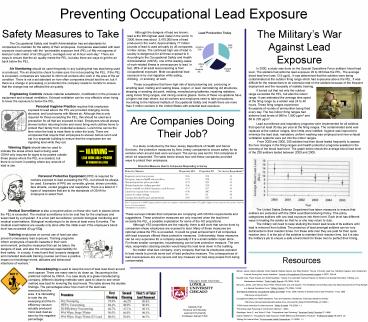Preventing Occupational Lead Exposure - PowerPoint PPT Presentation
Title:
Preventing Occupational Lead Exposure
Description:
Preventing Occupational Lead Exposure The Military s War Against Lead Exposure In 2000, a study was done on the Special Operations Force soldiers blood lead level. – PowerPoint PPT presentation
Number of Views:114
Avg rating:3.0/5.0
Title: Preventing Occupational Lead Exposure
1
Preventing Occupational Lead Exposure
The Militarys War Against Lead Exposure
In 2000, a study was done on the Special
Operations Force soldiers blood lead level. The
soldiers had airborne lead exposure 20 to 38
times the PEL. The average blood lead level was
13.9 µg/dL. It was determined that the soldiers
were being contaminated at the outdoor firing
range which had exposures above the PEL. It was
difficult for the researchers to do extensive
test on the soldiers because of the frequent
deployment and the necessity of realistic
training.
It turned out that not only the outdoor range
exceeded the PEL, but also the indoor range. It
was estimated the average time spent at the
firing range by a soldier was 24 to 40 hours.
These firing ranges experience thousands of
rounds of ammunition being fired every day. The
two indoor firing ranges had airborne lead levels
of 980 to 1,900 µg/m3 and 60 to 220 µg/m3.
Lead surveillance and respiratory programs were
implemented for all soldiers that spent at least
30 day per year at the firing ranges. The
contaminated sand was replaced at the outdoor
ranges, time limits were instilled, hygiene was
improved to minimize the lead dust, mandatory
uniform washing was employed and new exhaust
ventilation systems were put into the indoor
ranges. From 2000 and 2005, 255 soldiers had
their blood tested frequently to assess the how
changes in the firing ranges and health
protection programs assisted in the lowering of
the blood lead level. The graph below shows the
average blood lead level of the 255 soldiers
tested between 2000 and 2005. The
United States Defense Department has taken
measures to ensure that soldiers are protected
with the 2004 Lead Biomonitoring Policy. This
policy categorizes soldiers with any lead
exposure into three level. Each level has
different ways in treating the soldier so that he
or she may return to duty. The military will
need to keep studying the blood lead levels of
its soldiers until lead is removed from bullets.
The presence of lead amongst soldiers can be very
detrimental to their reaction times. For these
elite men they are paid for their quick reaction
time. It is the job of the soldiers to maintain
their reaction time, but it is also the
militarys job to ensure a safe environment for
these men to perfect their timing.
Resources
Blando, James, Daniel Lefkowitz, David Valiante,
Barbara Gerwel, and Eddy Bresnitz. "Survey of
Current Lead Use, Handling, Hygiene, and
Contaminant Controls Among New Jersey
Industries." Journal of Occupational
Environmental Hygiene 4 (2007) 539-46. Buzzetti,
Alan, Frank Greene, and Dottie Needham. "Impact
of a Lead-Safe Training Program on Workers
Conducting Renovation, Painting, and Maintenance
Activities." Public Health Reports 120 (2005)
25-30. Mancuso, James, John McCoy, Bruce Pelka,
Patrice Kahn, and Joel Gaydos. "The Challenge of
Controlling Lead and Silica Exposures from Firing
Ranges in a Special Operations Force." Military
Medicin 173 (2008) 182-86. The National
Institute for Occupational Safety and Health. 4
Dec. 2008. Centers of Disease Control and
Prevention. 7 Dec. 2008 lthttp//www.cdc.gov/niosh
/gt. Occupational Safety and Health Standards
Toxic and Hazardous Substances Employee standard
summary. lthttp//www.osha.gov/pls/oshaweb/owadisp
.show_document?p_tableSTANDARDSp_id10032.gt "OSH
A issues instruction for lead exposure." Safety
Health 178 (2008) 1-1. "Preventing Lead
Poisoning in Construction Workers."
(1992). Staudinger, Kevin C., and Victor S. Roth.
"Occupational Lead Poisoning." American Family
Physician 57 (1998). Swartz, Matthew A.
"Occupational Lead Exposure Health Effects and
Remediation Practices." Professional Safety 46
(2001) 28. "Wiping Out Lead at Work."
Environmental Health Perspectives 111 (2003) 1-1.
Cassidy Kist Science and Society Lead and
Humanity Professor Alanah Fitch































